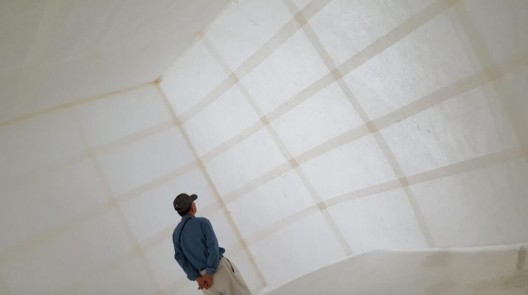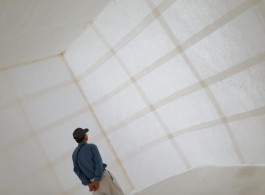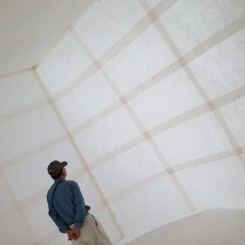Halaayt: Passages of Transcendence
Pearl Lam Galleries, Hong Kong
Hong Kong—Pearl Lam Galleries is delighted to present Korean artist Hoon Kwak’s first Hong Kong solo exhibition Halaayt: Passages of Transcendence across its two galleries in Hong Kong. On display at H Queen’s are a selection of paintings from the Tea Bowls series (1980) and Incantation series (1980), as well as two site-specific installations Kalpa/Sound: What Marco Polo Left Behind (1995), Poem (2012). A recent series of paintings titled Halaayt is featured at the Pedder Building.
Halaayt is an open term used by First Nations in the west coast of Canada to describe all things spiritual. In Tsimshian terminology, halaayt is a ceremony for connecting with ancestors through spiritual means in order to achieve a better understanding of the meaning of our existence in the universe.
Halaayt: Passages of Transcendence sheds light on the different trajectories of Kwak’s energetic and provocative art practice that covers a period of over 40 years. Fascinated by the ways in which we relate with nature through earthly and physical means, he breaks down the cultural boundaries by celebrating the universal values that make us human in the first place. Like a contemporary archaeologist of Korean antiquity, Kwak incorporates visual symbols from his past into his paintings to transcend notions of temporality and represent perseverance and survival in an increasingly fragmented world. The artist’s distinctive expressionist language deviates from the emphasis on flatness and monochromatic qualities of Dansaekhwa painting, a post war movement that originated in the 1970’s.
Born in 1941, Kwak experienced the trauma that resulted from the Korean War (1950–53) as a teenager, which triggered his instinctual attraction towards topics of human fate, mortality and recollection. He was at the forefront of contemporary Korean art in the 1960’s and worked as a member of the artist collective Painting 68 and the Korean Avant-Garde Association when Art Informel swept through Korea. Like many Asian artists at the time, Kwak and his wife emigrated to the United States in 1974 to experience the impact of abstract expressionism and pop art first-hand. Caught between being labelled as a Korean artist working in the United States and an American artist working in Korea, the artist soon felt the urgency to come to terms with his own identity.
Kwak’s Tea Bowls series from the 1980’s references his own biography. As a result of the destruction of his primary school during the Korean War, Kwak and his classmates were being forced to rebuild their own classrooms. While digging the ground, they found hundreds of buried antique ceramic flasks and tea bowls, or onggi, from the Silla dynasty. This event has proven to be a life-changing experience for the artist. Kwak states, “For my work, rather than looking for abstruse motives, I always used objects that would come my way.” Drawn by its ceremonial quality, the artist uses the tea bowl as a tool to practice asceticism. These still objects carry a sense of calmness and self-worth, yet their ephemeral representation appears to be ghostly as if it is going through its own permutation. In the Incantation series (1980), Kwak uses mixed media on paper to depict a truncated generic figure under restraint. Different degrees of pressure are imposed on an already frail body that is desperate for salvation. For the artist, both series are a means to come to terms with his traumatic experiences from the past.
Poem (2012) is a site-specific installation that uses hanji, a semi-transparent Korean traditional paper, to construct an introspective environment. Recalling his own childhood memory of living in makeshift communal camps and later becoming a guest of his grandfather’s hanok, or Korean traditional house, Kwak was deeply touched by the pure quality of morning light penetrating the window. With the formal economy and linear beauty of hanji and its transparent yet unique physical characteristics, Poem is an open invitation to the audiences to confront their fates and to achieve stasis with another world.
Kalpa/Sound, What Marco Polo Left Behind (1995–present) was first exhibited at the inaugural Korean pavilion at the 1995 Venice Biennale with a performance by Buddhist nuns. Kalpa is a Sanskrit word that defines a long period of time in Hindu and Buddhist cosmology. It also refers to the different cycles of life and death by means of extending or contracting time in the pursuit of samsara in Buddhism. The current edition of Kalpa/Sound is composed of a series of clay vessels that closely resemble traditional container used for fermenting food. Joining these disparate units together with the use of a bamboo structure and straw rope to form a large flute, or piri, this interactive instrument resonates a hollow tone as a result of nearby sounds or breeze. Its long shape suggests a traversal within the journey of life. In a post-modern era in which we embrace cultural diversity and freedom at face value, the actual clashes between different conflicting ideologies in fact demand a common vehicle for mutual reconciliation.

Halaayt is a series of recent paintings that Kwak has been developing over the last two years. Halaayt is a form of shamanistic healing experienced through a ceremonial being. Considered as a form of supernatural power by the indigenous community, the practice of halaayt is to achieve a higher level of epistemological understanding of where we stand in relation to a changing world. For Kwak, the intention is to bring positive changes to the world by making peace with nature itself. Halaayt describes different scenes of human figures pedalling a canoe and sailing adrift in open water or at times near a whale. Longing to connect to an uninhibited natural force, these mythical drifters are in fact fighting for survival. Such a desolate scene reminds us of the lone survivors who are on the brink of humanity in The Raft of Medusa by 19th century French romantic painter Théodore Géricault. In some of the paintings, rays of light painted in red descend on the canoe. Halaayt suggests a clash between human civilization and nature and questions the very meaning of our being in a changing world. Kwak’s fictional voyages in fact reaffirm a belief that nature is the sole and constant source of our spiritual sustenance. For there are no universal passages for a collective transcendence, but only to become more faithful with one’s spiritual journey. The artist recognizes this shared concern for all humans, as Kwak says, “My work is eventually a self-portrayal of myself.”


